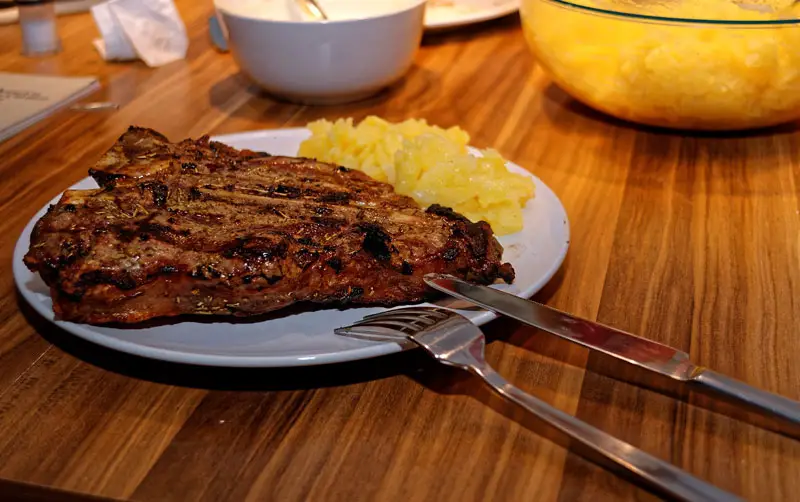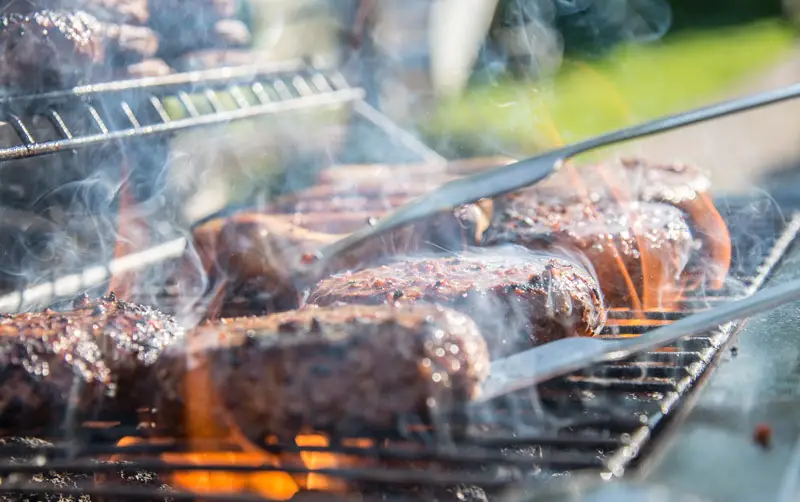Have you heard of both a porterhouse and T-bone steak but are confused about what the difference is? Aren’t they technically the same cut of meat, just with different names? Well, no, not exactly. If you want to know the real difference between the porterhouse and the T-bone steak, you’re in the right place. We’re here to help you can decide which to order the next time you’re out at a steakhouse or serve your guests at your next dinner party.
Are porterhouse and T-bone actually the same steaks?
Both the T-bone and the porterhouse are cut from the cow’s short loin section which is located in the back of the body and contains part of the spine, the top loin, and the tenderloin. The T-bone shaped bone that the T-bone is named after actually runs through both the porterhouse and the T-bone steak and contains a NY strip and a tenderloin fillet on either side of the bone.
So, what’s the difference?
So, we’ve established the similarities between a porterhouse and a T-bone steak but what are the differences, if any? The difference comes down to the size of the fillet. A porterhouse steak has more meat than a T-bone steak, but that’s not the only factor that qualifies a steak as a porterhouse. There are actually strict USDA guidelines that need to be met relating to the size for a steak to earn the name “porterhouse”.
The Porterhouse Steak
Simply put, a steak cut from the short loin section of the cow can be labeled as either a porterhouse or a T-bone steak. For a T-bone steak to be considered a porterhouse, though, the fillet has to be at least 1.25 inches thick. The thickness is, of course, not measured randomly but from the bone to the widest point of the fillet. Although both the porterhouse and the T-bone steak come from the short loin, porterhouses are cut from the rear, where the tenderloin is thickest. The result? A large, tender steak that is usually at least 24 ounces and can definitely feed more than one person.
The T-Bone Steak

So, what qualifies a steak to be a T-bone? Is it just any other cut of meat taken from the short loin? A steak can be called a T-bone if the fillet is at least a ¼ of an inch thick. If the steak’s fillet still doesn’t fall into that range, it can’t be sold as a porterhouse or a T-bone, but must be sold as either a bone-in NY strip steak or a club steak.
What to look for in a T-bone vs. a porterhouse steak
When choosing a T-bone or a porterhouse steak, you will notice that porterhouse steaks are much pricier than T-bone steaks. This is for good reason, the porterhouses are much thicker and contain more juicy, tender fillet than the T-bone steak. When selecting a porterhouse or a T-bone steak, however, pay attention to a few key factors when it comes to their appearance. While some steaks may technically qualify as porterhouses, the size may not be consistent throughout the cut, starting thick and then thinning in another section. Make sure you’re paying attention to the steak’s overall size when making your selection. A porterhouse that starts off thick at its largest point still earns the name, but you’re still getting while skimped out of some of the fillet.
When it comes to T-bone steaks, it’s not uncommon for them to have an overall larger fillet than a porterhouse steak – however, it is still not considered a porterhouse steak because it doesn’t hit that 1.25-inch mark. It can have more fillet overall, though, because the fillet is cut consistently instead of being thick in one section and thin in another. Make sense? So, if you’re considering porterhouse vs. ribeye and are more concerned about the size than its other subtle differences, take a look at the overall size of the T-bone. You just may end up getting more meat than a porterhouse and at a significantly lower price.
Grilling a T-bone or a porterhouse steak

What you need to keep in mind with both T-bone and porterhouse steaks is that they each contain two different types of meat. When grilling either of these steaks, it’s very beneficial to have a fire with two zones. Use less heat on the fillet side because it has much less fat than the other and cooks faster. You can apply more heat to the strip loin side because it has the fat content to withstand the heat and still cook beautifully.
Using a 100% natural wood charcoal is ideal for cooking these high-quality steaks because it allows the taste of the meat to be front and center – you do not want any additives altering the taste of this high-quality beef!
Seasonings
Coarse seasonings are best for cooking a porterhouse or T-bone steak, as they are with any steak, really. Salt and pepper are all you need to complement the flavor but you can certainly add any other spices you choose.
Realistically, you can’t go wrong with either a porterhouse or a T-bone steak. They’re both high quality, delicious selections of meat with one just being heavier and containing more fillet than the other. Whether you’re cooking these fillets at home or looking to go out to a restaurant and having a chef cook it for you, either steak is a great option. Just be prepared to either share the porterhouse or be incredibly full after trying to devour the whole thing. There are many fantastic restaurants with steak selections, but Longhorn Steakhouse is a fan favorite. Take a look at Longhorn Steakhouse’s menu and prices here.
Featured Photo by Alex Munsell on Unsplash

